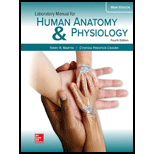
Compare the relative lengths and paths of the uterine tubes (oviducts) of the fetal pig and the human.
To write:
The difference between the comparative lengths and paths of the oviducts or uterine tubes of the fetal pig and human.
Introduction:
Anatomy can be defined as a branch of biology that is associated with the study of the organism’s structure and its parts. In anatomy, the superficial indicates the structure is closer to the surface of the body or presents more outside than another.
Explanation of Solution
Uterus:
It is an organ located in the lower body of a female mammal or woman. In this region, the offspring is conceived. It is known as a womb in which the fetus is gestating before birth.
The difference between the comparative lengths and paths of the oviducts or uterine tubes of the fetal pig and human:
| Difference criteria | Uterus of pig(uterine tubes) | Uterus of human female(uterine tubes) |
| 1. Shape | 1. The pig’s uterus is Y-shaped. It has branches that form the left and right uterine horns. | The human uterus has a single chamber. The offspring develops in this region. Humans lack the branches or uterine horns. |
| 2. Uterine tubes | These are small and coiled tubes located near the ovaries. They travel a small distance to meet the uterine horns. | These are larger and longer. They pass to the uterine body from the ovaries. They have a relatively long distance from the uterus. |
Uterine tubes are small and coiled tubes in fetal pigs than in humans.
Want to see more full solutions like this?
Chapter 68 Solutions
Laboratory Manual for Human Anatomy & Physiology Main Version
- Define and describe the main features of the following developmental stages: fertilization, cleavage, gastrulation.arrow_forwarddifferentiate the oogenesis and spermatogenesis of chicken and fruitfly.arrow_forwardTrace the pathway of the ova of the female frog from the place of production up to the place of release from the body. (Arrow pathway)arrow_forward
- Name the structure formed by the villi of the embryo and the uterus of the mother.arrow_forwardA: Why do sea urchins have external fertilization? [Discuss the life style of the developing sea urchin embryo in the water column compared to a very different ecological niche of the adults on the ocean floor. Besides, would you want to give live birth to a sea urchin! ouch!] 2: Then why don't the parents take care of the young? [In fact the adults do in a way. After the embryo has grown large enough and metamorphosed into a young urchin they hide in the spines of the adults, living off of the scraps of food produced from the messy eating of the adults] 3: Because the urchin life involves two or more ecological niches, they are more susceptible to predation and exposure to environmental toxins. What environmental conditions, predators and toxins might they be exposed to at each stage?arrow_forwardDescribe the anatomy of the human breast and how it differs from mammary tissue in other species.arrow_forward
- Draw one of the stages of the Human Pregnancy Series and label the following: placenta, uterus, cervix, vagina, fallopian tubes, ovaries, embryo, umbilical cord, amnion.arrow_forwardWhat are the distinguishable parts of the 72-hour chick embryo? Give at least 5 parts and the adult derivatives of each part.arrow_forwardCite differences between grasshopper and rat testis. Cite differences of spermatogenesis on grasshopper and rat.arrow_forward
- Which of the following is required for successful fetal development after the egg has been fertilized? a) That the corpus luteum remains throughout the pregnancy b) Production of estrogen (estradiol) and progesterone from the placenta c) Release of hCG (human chorionic gonatotropin) from the placentaarrow_forwardWhat is the technical term for the fertilized egg?arrow_forwardOutline the postfertilization events that lead to formation of a blastocyst.arrow_forward
 Human Biology (MindTap Course List)BiologyISBN:9781305112100Author:Cecie Starr, Beverly McMillanPublisher:Cengage Learning
Human Biology (MindTap Course List)BiologyISBN:9781305112100Author:Cecie Starr, Beverly McMillanPublisher:Cengage Learning Human Heredity: Principles and Issues (MindTap Co...BiologyISBN:9781305251052Author:Michael CummingsPublisher:Cengage Learning
Human Heredity: Principles and Issues (MindTap Co...BiologyISBN:9781305251052Author:Michael CummingsPublisher:Cengage Learning Biology (MindTap Course List)BiologyISBN:9781337392938Author:Eldra Solomon, Charles Martin, Diana W. Martin, Linda R. BergPublisher:Cengage Learning
Biology (MindTap Course List)BiologyISBN:9781337392938Author:Eldra Solomon, Charles Martin, Diana W. Martin, Linda R. BergPublisher:Cengage Learning



